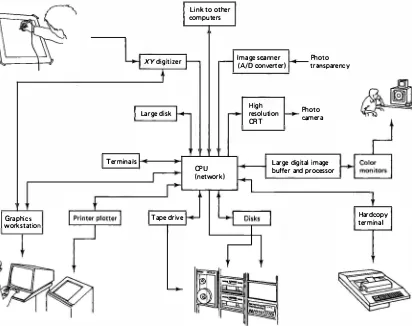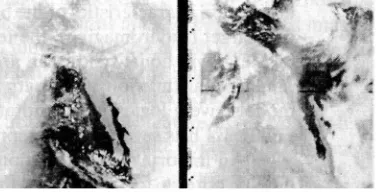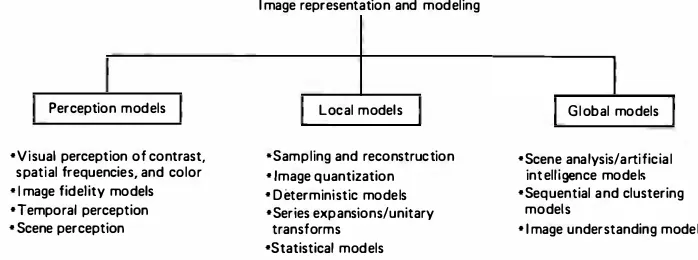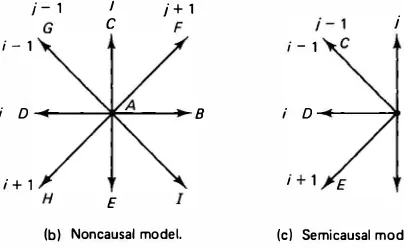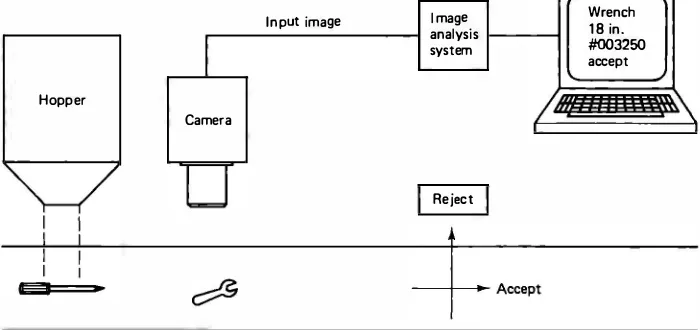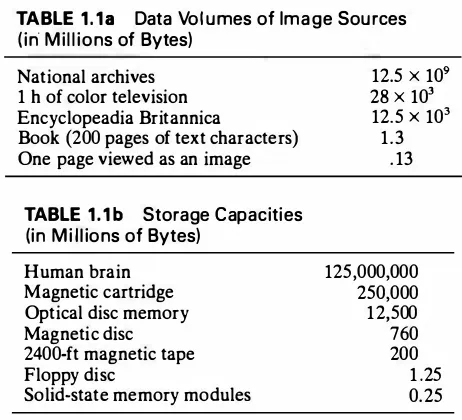Fundamentals
of Digital
Image Processing
ANIL K. JAIN University of California, Davis
1
Introduction
1 . 1 DIGITAL IMAGE PROCESSING : PROBLEMS AND APPLICATIONS
The term digital image processing generally refers to processing of a two dimensional picture by a digital computer. In a broader context, it implies digital processing of any two-dimensional data. A digital image is an array of real or complex numbers represented by a finite number of bits. Figure 1 . 1 shows a computer laboratory (at the University of California, Davis) used for digital image processing. An image given in the form of a transparency, slide, photograph, or chart is first digitized and stored as a matrix of binary digits in computer memory. This digitized image can then be processed and/or displayed on a high-resolution television monitor. For display, the image is stored in a rapid-access buffer memory which refreshes the monitor at 30 frames/s to produce a visibly continuous display. Mini- or microcomputers are used to communicate and control all the digitization, storage, processing, and display operations via a computer network (such as the Ethernet). Program inputs to the computer are made through a terminal, and the outputs are available on a terminal, television monitor, or a printer/plotter. Fig ure 1.2 shows the steps in a typical image processing sequence.
Digital image processing has a broad spectrum of applications, such as remote sensing via satellites and other spacecrafts, image transmission and storage for business applications, medical processing, radar, sonar, and acoustic image process ing, robotics, and automated inspection of industrial parts.
Images acquired by satellites are useful in tracking of earth resources; geo graphical mapping; prediction of agricultural crops, urban growth, and weather; flood and fire control; and many other environmental applications. Space image applications include recognition and analysis of objects contained in images ob tained from deep space-probe missions. Image transmission and storage
Graphics workstation
XY digitizer
Large disk
Terminals
Tape drive
Link to other computers
CPU (network)
Image scanner Photo (A/D converter) transparency
High
resolution Photo
CRT camera
Large digital image buffer and processor
Figure 1.1 A digital image processing system (Signal and Image Processing Laboratory, University of California, Davis).
Sample and quantize
Digital computer
Hardcopy terminal
Output Object Observe Digitize Store Process Refresh/
store
Record
Figure 1.2 A typical digital image processing sequence.
resonance (NMR), and ultrasonic scanning. These images may be used for patient screening and monitoring or for detection of tumors or other disease in patients. Radar and sonar images are used for detection and recognition of various types of targets or in guidance and maneuvering of aircraft or missile systems. Figure 1.3 shows examples of several different types of images. There are many other applica tions ranging from robot vision for industrial automation to image synthesis for cartoon making or fashion design. In other words, whenever a human or a machine or any other entity receives data of two or more dimensions, an image is processed.
Although there are many image processing applications and problems, in this text we will consider the following basic classes of problems .
(a) Space probe images: Moon and Mars. (b) multispectral images: visual and i nfrared.
II fll 11 Ill II
m�m�����
l-============ .II
:::::::::::: '
... �··· . . ...
�
::::::.::::::
(c) medical images: Xray and eyeball. (d) optical camera i mages: Golden Gate and downtown San Francisco.
(e) television images: girl, couple, Linda and Cronkite.
Figure 1.3 Examples of digital images.
1.
Image representation and modeling2.
Image enhancement3. Image restoration 4. Image analysis
5.
Image reconstruction 6. Image data compression1 .2 IMAGE REPRESENTATION AND MODELING
In image representation one is concerned with characterization of the quantity that each picture-element (also called pixel or pet) represents. An image could represent luminances of objects in a scene (such as pictures taken by ordinary camera), the absorption characteristics of the body tissue (X-ray imaging), the radar cross section of a target (radar imaging), the temperature profile of a region (infrared imaging), or the gravitational field in an area (in geophysical imaging). In general, any two dimensional function that bears information can be considered an image. Image models give a logical or quantitative description of the properties of this function. Figure 1 .4 lists several image representation and modeling problems.
An important consideration in image representation is the fidelity or intelli gibility criteria for measuring the quality of an image or the performance of a processing technique. Specification of such measures requires models of perception of contrast, spatial frequencies, color, and so on, as discussed in Chapter 3. Knowl edge of a fidelity criterion helps in designing the imaging sensor, because it tells us the variables that should be measured most accurately.
The fundamental requirement of digital processing is that images be sampled and quantized. The sampling rate (number of pixels per unit area) has to be large enough to preserve the useful information in an image. It is determined by the bandwidth of the image. For example, the bandwidth of raster scanned common television signal is about 4 MHz. From the sampling theorem, this requires a minimum sampling rate of 8 MHz. At 30 frames/s, this means each frame should contain approximately 266,000 pixels. Thus for a 512-line raster, this means each
Perception models
• Visual perception of contrast, spatial frequencies, and color • I mage fidelity models •Temporal perception • Scene perception
I mage representation and modeling
Local models
• I mage understanding models
I mage = a1• 1 81• 1 +a,, 2 81• 2 + . . . +a M,N
Figure 1.5 Image representation by orthogonal basis image series Bm,n·
image frame contains approximately 512 x 512 pixels. Image quantization is the analog to digital conversion of a sampled image to a finite number of gray levels. Image sampling and quantization methods are discussed in Chapter 4.
A classical method of signal representation is by an orthogonal series ex pansion, such as the Fourier series. For images, analogous representation is possible via two-dimensional orthogonal functions called basis images. For sampled images, the basis images can be determined from unitary matrices called image transforms. Any given image can be expressed as a weighted sum of the basis images (Fig. 1 .5). Several characteristics of images, such as their spatial frequency content, band width, power spectrum, and application in filter design, feature extraction, and so on, can be studied via such expansions. The theory and applications of image transforms are discussed in Chapter 5.
Statistical models describe an image as a member of an ensemble, often characterized by its mean and covariance functions. This permits development of algorithms that are useful for an entire class or an ensemble of images rather than for a single image. Often the ensemble is assumed to be stationary so that the mean and covariance functions can easily be estimated. Stationary models are useful in data compression problems such as transform coding, restoration problems such as Wiener filtering, and in other applications where global properties of the ensemble are sufficient. A more effective use of these models in image processing is to con sider them to be spatially varying or piecewise spatially invariant.
To characterize short-term or local properties of the pixels, one alternative is to characterize each pixel by a relationship with its neighborhood pixels. For example, a linear system characterized by a (low-order) difference equation and forced by white noise or some other random field with known power spectrum density is a useful approach for representing the ensemble. Figure 1.6 shows three types of stochastic models where an image pixel is characterized in terms of its neighboring pixels. If the image were scanned top to bottom and then left to right, the model of Fig. l .6a would be called a causal model. This is because the pixel A is characterized by pixels that lie in the "past." Extending this idea, the model of Fig. l .6b is a noncausal model because the neighbors of A lie in the past as well as the "future" in both the directions. In Fig. l.6c, we have a semicausal model because the neighbors of A are in the past in the j-direction and are in the past as well as future in the i-direction.
Such models are useful in developing algorithms that have different hardware realizations. For example, causal models can realize recursive filters, which require small memory while yielding an infinite impulse response (IIR). On the other hand,
j - 1 j
Figure 1.6 Three canonical forms of stochastic models.
noncausal models can be used to design fast transform-based finite impulse re sponse (FIR) filters. Semicausal models can yield two-dimensional algorithms, which are recursive in one dimension and nonrecursive in the other. Some of these stochastic models can be thought of as generalizations of one dimensional random processes represented by autoregressive (AR) and autoregressive moving average (ARMA) models. Details of these aspects are discussed in Chapter 6.
In global modeling, an image is considered as a composition of several objects.
Various objects in the scene are detected (for example, by segmentation tech niques), and the model gives the rules for defining the relationship among various objects. Such representations fall under the category of image understanding models, which are not a subject of study in this text.
1 .3 IMAGE ENHANCEMENT
In image enhancement, the goal is to accentuate certain image features for subse quent analysis or for image display. Examples include contrast and edge enhance ment, pseudocoloring, noise filtering, sharpening, and magnifying. Image enhance ment is useful in feature extraction, image analysis, and visual information display. The enhancement process itself does not increase the inherent information content in the data. It simply emphasizes certain specified image characteristics. Enhance ment algorithms are generally interactive and application-dependent.
f(o:, {3) g(x, y)
f3 I nput
h(x, y; o:, {31
Imaging
system Output
0 0
Figure 1.7 Blurring due to an imaging system. Given the noisy and blurred im age the image restoration problem is to find an estimate of the input image f (x, y ).
1 .4 IMAGE RESTORATION
Image restoration refers to removal or minimization of known degradations in an image. This includes deblurring of images degraded by the limitations of a sensor or its environment, noise filtering, and correction of geometric distortion or non linearities due to sensors. Figure 1 . 7 shows a typical situation in image restoration. The image of a point source is blurred and degraded due to noise by an imaging system. If the imaging sytem is linear, the image of an object can be expressed as
g(x, y) =
f,,f.,
h(x, y ; a, 13)f (a, 13) dadl3 + TJ (x, y) (1.1)where TJ(X, y) is the additive noise function,f(a, 13) is the object, g(x, y) is the image, and h (x, y ; a, 13) is called the point spread function (PSF). A typical image restora tion problem is to find an estimate off(a, 13) given the PSF, the blurred image, and the statistical properties of the noise process.
A fundamental result in filtering theory used commonly for image restoration is called the Wiener filter. This filter gives the best linear mean square estimate of the object from the observations. It can be implemented in frequency domain via the fast unitary transforms, in spatial domain by two-dimensional recursive tech niques similar to Kalman filtering, or by FIR nonrecursive filters (see Fig. 8.15). It can also be implemented as a semirecursive filter that employs a unitary transform in one of the dimensions and a recursive filter in the other.
Several other image restoration methods such as least squares, constrained least squares, and spline interpolation methods can be shown to belong to the class of Wiener filtering algorithms. Other methods such as maximum likelihood, max imum entropy, and maximum a posteriori are nonlinear techniques that require iterative solutions. These and other algorithms useful in image restoration are discussed in Chapter 8.
1 .5 IMAGE ANALYSIS
Image analysis is concerned with making quantitative measurements from an image to produce a description of it. In the simplest form, this task could be reading a label on a grocery item, sorting different parts on an assembly line (Fig. 1 .8), or
Hopper
I nput image I mage analysis system
Wrench 1 8 in. #003250 accept
Camera
Reject
Figure 1.8 Parts inspection and sorting on an assembly line.
measuring the size and orientation of blood cells in a medical image. More advanced image analysis systems measure quantitative information and use it to make a sophisticated decision, such as controlling the arm of a robot to move an object after identifying it or navigating an aircraft with the aid of images acquired along its trajectory.
Image analysis techniques require extraction of certain features that aid in the identification of the object. Segmentation techniques are used to isolate the desired object from the scene so that measurements can be made on it subsequently. Quantitative measurements of object features allow classification and description of the image. These techniques are considered in Chapter 9.
1 .6 IMAGE RECONSTRUCTION FROM PROJECTIONS
Image reconstruction from projections is a special class of image restoration prob lems where a two- (or higher) dimensional object is reconstructed from several one-dimensional projections. Each projection is obtained by projecting a parallel X ray (or other penetrating radiation) beam through the object (Fig. 1 .9). Planar projections are thus obtained by viewing the object from many different angles. Reconstruction algorithms derive an image of a thin axial slice of the object, giving an inside view otherwise unobtainable without performing extensive surgery. Such techniques are important in medical imaging (CT scanners), astronomy, radar imag ing, geological exploration, and nondestructive testing of assemblies.
�
Reconstruction algorithm
-
---r
x rays-- -
f
Figure 1.9 Image reconstruction using X-ray CT scanners.
1 .7 IMAGE DATA COMPRESSION
The amount of data associated with visual information is so large (see Table l . la) that its storage would require enormous storage capacity. Although the capacities of several storage media (Table 1 . 1 b) are substantial, their access speeds are usually inversely proportional to their capacity. Typical television images generate data rates exceeding 10 million bytes per second. There are other image sources that generate even higher data rates. Storage and/or transmission of such data require large capacity and/or bandwidth, which could be very expensive. Image data com pression techniques are concerned with reduction of the number of bits required to
store or transmit images without any appreciable loss of information. Image
trans-Sec. 1 .7
TABLE 1 . 1 a Data Volumes of Image Sources (in Millions of Bytes)
National archives 1 h of color television Encyclopeadia Britannica
Book (200 pages of text characters) One page viewed as an image
mission applications are in broadcast television; remote sensing via satellite, air craft, radar, or sonar; teleconferencing; computer communications; and facsimile transmission. Image storage is required most commonly for educational and busi ness documents, medical images used in patient monitoring systems, and the like. Because of their wide applications, data compression is of great importance in digital image processing. Various image data compression techniques and examples are discussed in Chapter 11.
B I B L I O G R A P H Y
For books and special issues of journals devoted to digital imaging processing:
1. H. C. Andrews, with contribution by W. K. Pratt and K. Caspari. Computer Techniques in Image Processing. New York: Academic Press, 1970.
2. H. C. Andrews and B. R. Hunt. Digital Image Restoration. Englewood Cliffs, N.J.: Prentice-Hall, 1977.
3. K. R. Castleman. Digital Image Processing. Englewood Cliffs, N.J.: Prentice-Hall, 1979.
4. M.P. Ekstrom (Ed.). Digital Image Processing Techniques. New York: Academic Press,
1984.
5. R. C. Gonzalez and P. Wintz. Digital Image Processing, 2nd ed. Reading, Mass.:
Addison-Wesley, 1987.
6 .. E. L. Hall. Computer Image Processing and Recognition. New York: Academic Press,
1979.
7. T. S. Huang (ed.). Topics in Applied Physics: Picture Processing and Digital Filtering,
Vol. 6. New York: Springer-Verlag, 1975. Also see, Vols. 42-43, 1981.
8. S. Lipkin and A. Rosenfeld. Picture Processing and Psychopictorics. New York: Aca demic Press, 1970.
9. W. K. Pratt. Digital Image Processing. New York: Wiley-Interscience, 1978.
10. A. Rosenfeld and A. C. Kak. Digital Image Processing, Vols. I and II. New York:
Academic Press, 1982.
